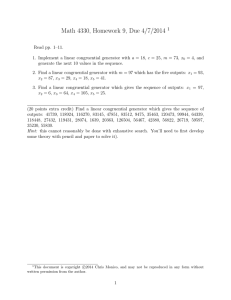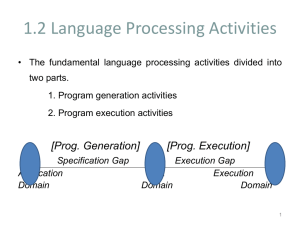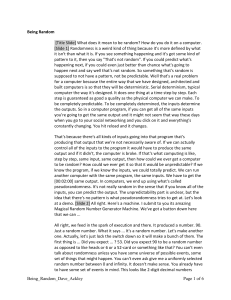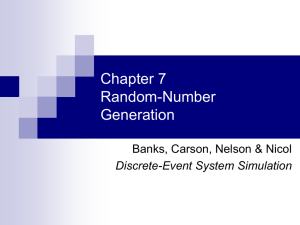Random Number Generator
advertisement
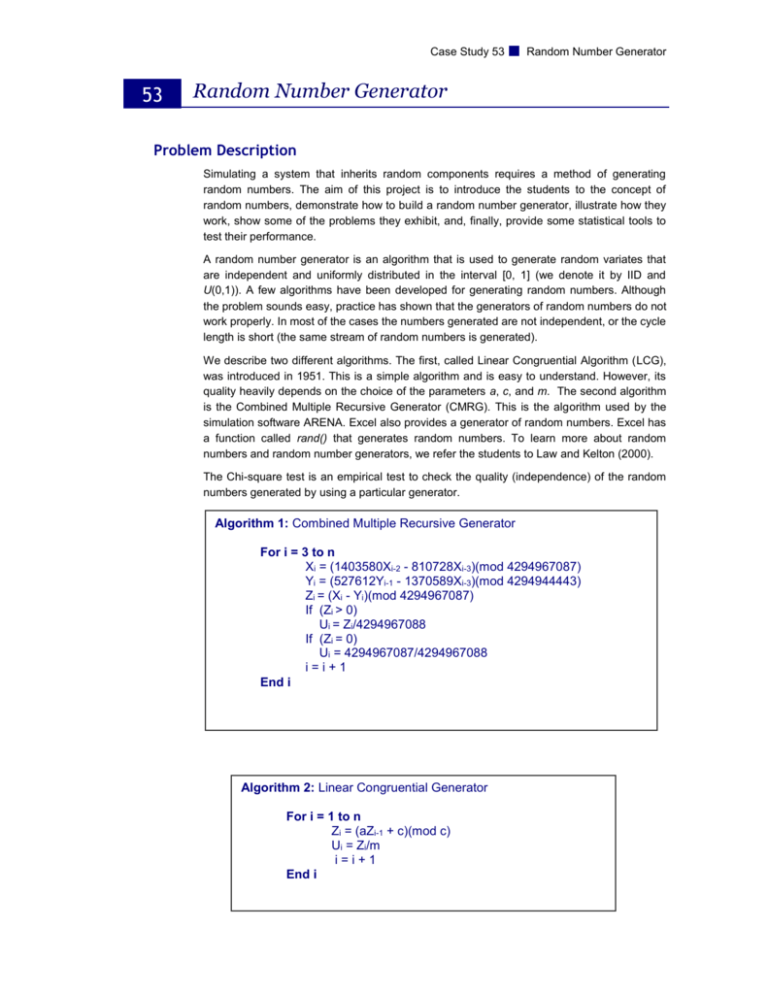
Case Study 53
53
Random Number Generator
Random Number Generator
Problem Description
Simulating a system that inherits random components requires a method of generating
random numbers. The aim of this project is to introduce the students to the concept of
random numbers, demonstrate how to build a random number generator, illustrate how they
work, show some of the problems they exhibit, and, finally, provide some statistical tools to
test their performance.
A random number generator is an algorithm that is used to generate random variates that
are independent and uniformly distributed in the interval [0, 1] (we denote it by IID and
U(0,1)). A few algorithms have been developed for generating random numbers. Although
the problem sounds easy, practice has shown that the generators of random numbers do not
work properly. In most of the cases the numbers generated are not independent, or the cycle
length is short (the same stream of random numbers is generated).
We describe two different algorithms. The first, called Linear Congruential Algorithm (LCG),
was introduced in 1951. This is a simple algorithm and is easy to understand. However, its
quality heavily depends on the choice of the parameters a, c, and m. The second algorithm
is the Combined Multiple Recursive Generator (CMRG). This is the algorithm used by the
simulation software ARENA. Excel also provides a generator of random numbers. Excel has
a function called rand() that generates random numbers. To learn more about random
numbers and random number generators, we refer the students to Law and Kelton (2000).
The Chi-square test is an empirical test to check the quality (independence) of the random
numbers generated by using a particular generator.
Algorithm 1: Combined Multiple Recursive Generator
For i = 3 to n
Xi = (1403580Xi-2 - 810728Xi-3)(mod 4294967087)
Yi = (527612Yi-1 - 1370589Xi-3)(mod 4294944443)
Zi = (Xi - Yi)(mod 4294967087)
If (Zi > 0)
Ui = Zi/4294967088
If (Zi = 0)
Ui = 4294967087/4294967088
i=i+1
End i
Algorithm 2: Linear Congruential Generator
For i = 1 to n
Zi = (aZi-1 + c)(mod c)
Ui = Zi/m
i=i+1
End i
Case Study 53
Random Number Generator
Empirical Test: Chi-square test
1.
2.
3.
4.
5.
Ho: Ui are IID U(0,1)
Divide [0,1] into k sub-intervals of equal length
fj is the number of Ui’s in the jth interval
Generate U1, U2, … Un
Calculate
2
k k
n
( f j k )2
n j 1
k21,1 (k 1)1
6. If (
2
2
k 1,1
2
2
z1
9(k 1)
9(k 1)
) we reject the Null Hypothesis (Ho)
User Interface
1.
Build a welcome form.
2.
Build a data analysis form. The following are suggestions to help you design this form.
a.
3.
Insert a frame that includes three option buttons. The option buttons allow the user
to choose whether the stream of random numbers will be generated using the
Linear Congruential Generator, the Combined Multiple Recursive Generator, or the
Excel rand() function.
i.
If the user chose to use the Linear Congruential Generator, four text boxes
appear where the user can type the value of the coefficients c, m, a, and Z0.
ii.
If the user chose to use the Combined Multiple Recursive Generator, six text
boxes appear where the user can type in the value of the coefficients X0,
X1, X2, Y0, Y1, and Y2.
b.
Insert a text box where the user can type in the total number of random numbers to
be generated (n).
c.
Insert a check box that enables the user to choose whether to perform the Chisquare test to check the performance of the generator.
d.
Insert a command button that, when clicked on, generates the random numbers
using the algorithm selected by the user.
Build a form to allow the user to open the reports described below. Use option buttons.
Design a logo for this project. Insert this logo in the forms created above. Pick a background
color and a font color for the forms created. Include the following in the forms created: record
navigation command buttons, record operations command buttons, and form operations
command buttons as needed.
K T
K T
K T
k 1t 1
k 1t 1
k 1t 1
min : ckt xkt hkt I kt Fkt z kt
Case Study 53
Subject to :
K
zkt 1 Reports
k 1
xkt I k ,t 1 I kt d kt
xkt Pkt z kt
xkt , I kt 0
z kt {0,1}
1.
for t 1,..., T ,
Random Number Generator
(1)
Report streams of 30 random numbers generated using the Linear Congruential
for k 1the
,...,Combined
K ; t 1,...,Multiple
T,
(Recursive
2)
Generator,
Generator, and Excel.
2.
for kthe
1result
,..., K ;from
t 1the
,...,Chi-square
T,
(3) test for each stream.
Report
3.
Plot the stream of random numbers generated.
4.
Present a stream of 30 random numbers generated using the Linear Congruential
Generator for the following choice of parameters: a = 5, c =3, and m = 16. Interpret the
results.
5.
Present a stream of 30 random numbers generated using the Linear Congruential
Generator for the following choice of parameters: a = 5, c =3, and m = 2 31 -1. Compare
these results with the results found in Report 4.
for k 1,..., K ; t 1,..., T ,
(4)
for k 1,..., K ; t 1,..., T .
(5)
Reference
Law, A.M., Kelton, W.D., “Simulation Modeling and Analysis.” 3rd Ed., McGraw-Hill, 2000.
